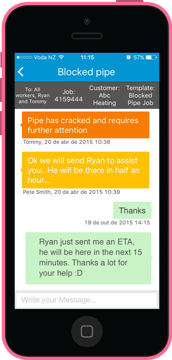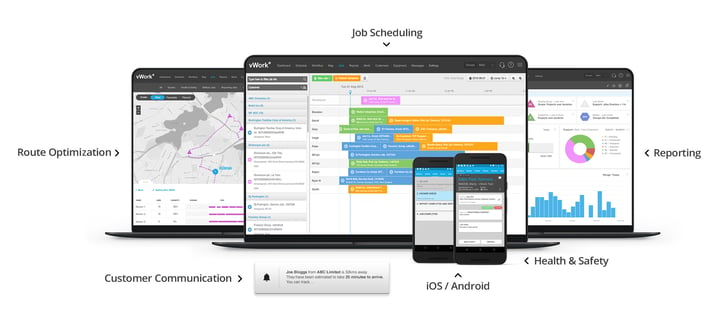These days, running a profitable business requires something different than it used to - especially if you have workers out in the field. Competition is tighter. Businesses are often forced to do more with fewer resources. And, it’s no longer enough to show up and provide top-notch service. Those things help, and you certainly can’t be profitable without them, but there’s more to it now. You have to be forward-thinking.
Running a modern business means taking those tried and true ideals and mashing them up with modern technology to create systems that allow you to work smarter and make more money.
Here are 10 proven tactics to help you bring a modern approach to dispatching your mobile workers ad field technicians and as a result be more profitable. After all, what is not to like about increasing your profits?
Legacy systems have had their day. It wasn’t that long ago that older systems were the gold standard for running a business. Legacy systems extend from paper-based schedules to spreadsheets and clunky old software that hasn’t kept up with the times.
But that time has passed.
These days, legacy systems end up creating more work than needed. The lack of connectivity around the various legacy systems that you’re using means that, if you want a specific piece of information, you have to access a specific system, which could be a clunky old platform or a filing cabinet. People end up having to go out of their way to find the information they’re looking for, eating up both time and money.
With modern systems, there are no filing cabinets to dig through or older systems to keep propped up. It's time to harness technology to automate as much as possible.
Keeping your information in a single, centralized system makes life easier for everyone at your company. Instead of having a platform for scheduling, a platform for health and safety, and a platform for invoicing, keep everything in one system. Or at least have a set-up that shares the key data between all your business tools.
The big thing this does is cut down on costs from having multiple systems managing your business. Consolidating your information also cuts down on the amount of time people spend both entering (and often re-entering) and accessing that information. Instead of logging into different software to do everything, there’s a single point of entry that does it all.

If you’re still setting up calendar reminders to manage your scheduled maintenance contracts, you’re adding more steps to the process than necessary. Not only can calendar reminders be easy to forget or miss, but once they go off you still have to reach out to the customer and schedule a time. The same applies to keeping this detail in a spreadsheet - it’s too easy to lose the information.
Running a profitable business is about cutting out the extra steps (and not losing revenue that you've worked hard to win).
Instead of setting up a reminder to let you know you have to schedule some maintenance, use a system that schedules the job as well as informs the customer when they can expect the technician at the same time. No missed reminders. And no more extra steps.
As an added bonus, a system like this allows you to have a complete view of what everyone in the company is doing on any given day. You can take a company-wide look at the schedule, to see if there are holes that can be filled. And, you can make sure the workload is evenly distributed at a technician level, to make sure no one is taking on more than they can handle.
Current solutions do an amazing job of collecting all the data related to your business.
Everything you do inside the system is captured. To some, this might sound invasive, but when you’re running a business, this kind of information is invaluable.
You have access to all the information you need to streamline your business and create better systems. Data will help you learn things like:

This data helps you make informed decisions that can help you send the right person to the right job and maintain a highly managed inventory, to help you make better use of available space.

Being able to get a real-time view about the status of each job means you don’t have to guess whether or not you have the capacity to take on more jobs or when you’ll be able to. And the dispatcher doesn’t have to interrupt the technician with a phone call to check their availability for on-the-day changes.
You know exactly what your capacity is at any given moment and can schedule accordingly. If you know that a bunch of projects are set to wrap up in two days, you can schedule more work to start in three.
You can take this one step further to schedule and assign work through your system, to prevent technicians from having to make a trip back to the office to check-in.
When you run an operation where most of your employees are out in the field all day, being mobile-first just makes sense.
When you equip your team with the tools they need to manage their day through their phones, you give them a way to provide real-time updates without calling in, to provide any information to customers that they may need, and you can update employees in the field about emergency work or other relevant information.
You give your team a way to operate independently, without having to sacrifice the ability to know exactly what’s happening with your team.
Automation has been a game-changer for almost every industry and yours is no exception. Removing the manual little tasks that fill up most days, allows your mobile workers (and office staff) to focus on tasks that add more value.
This includes automating daily tasks like:
Creating a system that lets you enter a few pieces of information to get an automatically generated and submitted invoice, for example, saves technicians from having to come back to the office, find the sheets where they recorded job info, manually enter the info, and then send off the invoice via email. Everything is handled efficiently and in a timely manner.

There isn’t a lot of room for error when it comes to occupational safety and health requirements.
Ensuring that technicians are safe from the various dangers they encounter while on a job site is critical and using a system that informs technicians of the dangers of the job can help prevent incidents.
Anything you can do to make compliance easier can save lives.
The best solution is a system that highlights the potential hazards right on the job sheet and makes technicians acknowledge that they have followed proper pre-start checks and processes. And it makes sure they are fully aware of hazards.
Having a standard, easy-to-fill-out set of job sheets makes life easier for everyone. Because these sheets are often filled out by dispatchers, who have to collect the information from technicians in the field, there’s always the risk that the technician will say one thing and the dispatcher will hear another.
With the right system, all the information the dispatcher needs is right there and the risk of entering the wrong thing is greatly reduced. And in the process using standardized job sheets adds to service reliability.

When it comes to keeping your customers up to date, there’s no such thing as too many updates. With a mobile-first solution, technicians and dispatchers can provide accurate, up-to-the-minute information about when the tech will arrive, updates on the job status, and any delays that you may be experiencing.
By doing this, you help customers manage things better on their end, so they’re more prepared for the work that’s being done. It’s one of those little details that can turn a one-time customer into a repeat customer.
Now that you know how to run a more efficient and profitable operation for your mobile workers, here’s the best part - you can do all of these things from one software solution.
We can help you create a more profitable business by giving you software that streamlines operations, automates repetitive tasks, and helps you communicate better with customers.

To find out more about how we can help you, contact us today or book a demo with a specialist.